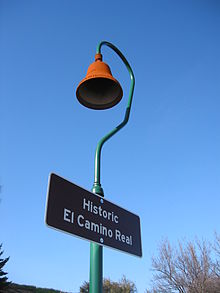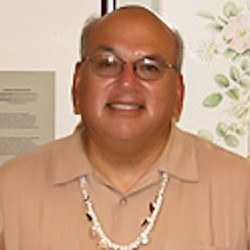Guest column by Valentin Lopez: Mission bells are a symbol of the enslavement of California’s native peoples
Tribal community today continues to suffer from the impacts of historical trauma resulting from three violent and destructive periods of colonization
![]()

By Valentin Lopez

Val Lopez
Any day now, the city of Gilroy plans to install a new El Camino Real mission bell marker downtown as part of the Gilroy Historical Paseo project. As many are aware, our tribe, the Amah Mutsun Tribal Band, has asked the city to reconsider this plan. Earlier this month we were very discouraged when, following our request, the city council voted to not place this matter on their agenda for discussion. I’d like to share with the Gilroy community some of the reasons why this issue is so significant to our tribe.
The Amah Mutsun Tribal Band is comprised of descendants of the indigenous peoples who were taken to the San Juan Bautista and Santa Cruz missions, and Gilroy is part of our ancestral homeland. Many of our most honored and remembered ancestors lived in the Gilroy area, including the legendary healer Ascención Solórsano. Though often overlooked, our people have always been part of Gilroy’s community, and some of our families reside in Gilroy to this day.
Our tribal community today continues to suffer from the impacts of historical trauma resulting from three violent and destructive periods of colonization in the Spanish, Mexican and American periods which sought to displace and erase us. Today we are actively working toward healing, and part of that healing is acknowledging the true history of the painful atrocities our families have endured.
For our tribal community, the mission bell is a potent symbol of the enslavement of our ancestors in the California mission system. The mission bell was used by missionaries in the Spanish missions to regiment a daily schedule of mandatory prayer and compulsory labor. Failure to respond to the call of the bell could result in severe punishment. The bell towered above our ancestors, enforcing the domination of the Catholic Church and the Spanish state over all aspects of their lives.
The mission bell symbol and the mythical concept of “El Camino Real” were adopted by civic boosters, automobile clubs, and women’s clubs in the early 20th century as part of an Anglo-American movement to reclaim the missions as romantic outposts of a pastoral and peaceful past. These rosy, false depictions of the California missions have long papered over the experiences of California’s tribal peoples during the abusive reign of Spanish occupation and internment in the mission system, during which about 90 percent of our population perished.
I have heard a number of Gilroy residents state that while members of our tribe see the mission bell as a harmful symbol, that is just one perspective. For many other members of the public, the bell markers are regarded as handsome symbols that celebrate California’s history. So, why should the viewpoint of a minority be prioritized? One reason is because the symbol of the bell impacts our tribal members in a distinctive and severe manner, as a result of the historical trauma that we carry.
In a similar way, Confederate flags and statues are seen by many Americans as proud depictions of history and heritage. However, for those whose families suffered through slavery and subsequent decades of discrimination and white supremacist violence, these symbols on public display take a heavy toll. Today, many cities and states are choosing to remove Confederate statues and other similar monuments, and listen to the communities most impacted by the display of these symbols.
 As tribal chair, I do not want our young tribal members to have to walk through public plazas under the shadow of the mission bell any longer. It is painful for them to see that, in essence, the mission system that sought to destroy our people continues to be celebrated and venerated in California today. And even more so, to realize that when we do speak up and ask for changes, more often than not we are dismissed and ignored.
As tribal chair, I do not want our young tribal members to have to walk through public plazas under the shadow of the mission bell any longer. It is painful for them to see that, in essence, the mission system that sought to destroy our people continues to be celebrated and venerated in California today. And even more so, to realize that when we do speak up and ask for changes, more often than not we are dismissed and ignored.
Our tribe and others across the state have been working for years to create public dialogue about the true history of the missions, and to gain the removal of these mission bell markers from public spaces. In 2020, following community discussions, the city of Santa Cruz took unanimous action to remove all the El Camino Real bell markers within the city’s jurisdiction. The city of Hayward recently chose to remove an El Camino Real bell from its Heritage Plaza renovation plan, and other cities are also considering the removal and replacement of these bell markers.
 Our tribe will continue to ask the city of Gilroy to reverse the decision to install a new mission bell, and to instead work with our tribe and other interested parties to develop a more respectful and appropriate marker to celebrate the city’s history. We would greatly appreciate any support from local community members in working towards a positive outcome that would contribute to healing for the whole community.
Our tribe will continue to ask the city of Gilroy to reverse the decision to install a new mission bell, and to instead work with our tribe and other interested parties to develop a more respectful and appropriate marker to celebrate the city’s history. We would greatly appreciate any support from local community members in working towards a positive outcome that would contribute to healing for the whole community.
Valentin Lopez is the tribal chair of the Amah Mutsun Tribal Band. He wrote this column for Gilroy Life.
